Dinger's Aviation Pages
SKUAS OVER NORWAY
The Germans invaded Norway on the night of the 8th/9th of April 1940. On the 10th of April, the Skuas of 800 and 803 Squadrons carried out their daring and successful attack on the German light cruiser Königsberg in Bergen harbour.
The Luftwaffe kept up the pressure on the Royal Navy's anchorage at Scapa Flow, including a raid by no less than 60 bombers on the 10th April (the same day as the sinking of the Königsberg), which was driven off by Navy Sea Gladiators and RAF Hurricanes. 801 Squadron flew north to join 800 and 803 Squadrons at Hatston. On the 12th of April, the three squadrons launched a strike by 20 aircraft on shipping in Bergen harbour. A single Skua was lost, but the crew escaped back to the UK after four weeks of being on the run from the Germans. On the 14th two separate Skua raids attacked Bergen, the last of which spectacularly sunk the freighter Barenfels, but at the cost of a Skua and its crew (Captain Eric D. McIver and LA Albert Barnard). A Heinkel 115 floatplane was also sunk at its moorings by a Skua strafing attack.
On the morning of 16th April, two Skuas did a low-level recce of Bergen. One strafed and bombed the German submarine U-58, without effect. The other attacked the torpedo boat Brand, a Norwegian vessel taken over by the Germans. Six Germans aboard the Brand were wounded. On the 17th, two more Skuas did another recce of Bergen, one of them attacked what they reported as the gunnery training ship Bremse. In the afternoon, Skuas of 803 and 801 Squadrons patrolled over the damaged cruiser HMS Suffolk and shot down a Dornier 18, badly damaged another Do 18 (which crash-landed and was written off) and a Henkel 111 and chased off other enemy aircraft including one of the fast Ju88 bombers.

The old Norwegian torpedo boat HNoMS Brand was captured by the Germans when they occupied Bergen. It was being used to take a party of Germans to seize the Norwegian floatplane base on the island of Flatøy when it was attached and bombed by a Blackburn Skua. Johannes Fosse, who as a schoolboy witnessed the attack, said a least eight bombs were dropped by the Skua, indicating that small 25 lb Cooper bombs were used in the attack. Another report says a bomb penetrated the boiler room of the Brand but did not explode, so maybe a larger 250 lb GP or 100 lb AS bomb was dropped at the same time. Six Germans were injured in the attack. The Brand had to be towed back to Bergen for repairs. Photo courtesy of Vidar Gjelsten.
On the 20th of April, another Skua raid on shipping around Bergen took place, a Skua crew being lost on the flight back. A single Skua did a recce to Larvik and attacked a German patrol boat and submarine on the flight back.
When the German's invaded Norway the carriers HMS Ark Royal and HMS Glorious were both in Alexandria in the Eastern Mediterranean. They were recalled to the Home Fleet and arrived in Scapa on the 21st of April. The following day the Skua squadrons were embarked, 800 Squadron ( 9 Skuas and 2 Rocs) and 801 Squadron (9 Skuas and 3 Rocs) went aboard Ark Royal while 803 Squadron (11 Skuas) went aboard the Glorious. Unfortunately, a 12th Skua crashed overboard when trying to land on Glorious, the TAG, leading aircraftsman Ken Brown, being killed. Onboard Glorious were 17 Sea Gladiators of 802 and 804 Squadrons FAA and 18 Gladiators of 263 Squadron RAF (made up of 17 RAF Gladiator IIs and a single Sea Gladiator lent from 802 Squadron).
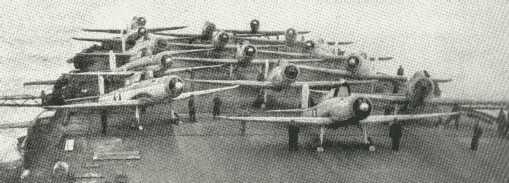
15 Skuas ranged aft on Ark Royal with engines running. Note the large exhaust stains along the starboard sides of the Skuas.
The carriers were to provide cover for British landings at Namsos and Aandalsnes, intended to take the major port of Trondheim in a pincer movement from the north and south. The plan was for the Sea Gladiators to protect the fleet while the longer-range Skuas would operate as both bombers and fighters over the British forces ashore with additional support to be given by the RAF Gladiators who were to operate from the surface of the frozen lake Lesjaskog near Aandalsnes. Radar cover was provided by the cruiser HMS Curlew which had a Type 79 radar with a range, in ideal conditions, of 80 miles. The force sailed on the 23rd April, that evening the Curlew picked up a force of 3 Heinkel 111 bombers and six Skuas were launched which saw off the Heinkels, damaging one. This was the first-ever radar-controlled interception at sea.
Having flown off the RAF Gladiators on the morning of the 24th of April (a single Skua lead the fighters to their destination) the carriers stayed a substantial distance from the Norwegian coast. The Skuas flew patrols over Aandalsnes and a force of Luftwaffe bombers was engaged by 803 Squadron who claimed two Heinkel 111s destroyed and a Dornier 17 damaged. One of the Skuas of 800 Squadron, L3050 flown by Midshipman Treene with observer Naval Airman "Doc" Goble, ran out of fuel on the final approach to land back on the Ark Royal and had to ditch; both crewmen were rescued by a destroyer (to read about this and further adventures click here). The next day (25th) a dawn strike (in two waves) was launched by both Skuas and Swordfish on the harbour and Luftwaffe bases at Trondheim. the first wave destroyed four Heinkel 115 floatplanes and damaged three more. One Skua was hit by AA fire and crashed but the crew were later rescued (for details of one crew's escape see Skua Postscripts ). The second wave of Skuas attacked two merchant ships and then went on to damage a Ju 88 bomber that was taking off from a frozen lake, they also shot down a Heinkel 115 floatplane. However on the way back to their carrier, a weather front was encountered and 3 Skuas were forced back and had to crash-land, all the crews were later rescued. On the same day, a bitter blow was dealt by the Luftwaffe when they destroyed all but 5 of the RAF Gladiators operating from Lake Lesjaskog and made the lake unusable through bombing. The remaining RAF Gladiators operated from Setnesmoen nearer to Aandalsnes the following day but by the evening of the 26th only one Gladiator survived and that had to be destroyed due to lack of fuel. Thus the weight of protecting the forces ashore from air attack fell on the Skuas, with only the scanty support of a single squadron of long-range Blenheim fighters based in the UK, operating at the limit of their range.
On the 26th of April, Skuas on patrol over Aandalsnes carried out 8 interceptions and claimed 2 Heinkel 111s destroyed and another three Heinkel 111s and a Heinkel 115 floatplane damaged. A Skua from 803 Squadron was lost this day, its pilot Lieutenant Cecil Howard Filmer survived and was rescued but his gunner, Petty Officer Baldwin, was killed. One of the Heinkels shot down by Skuas that day was recovered in 1976 and is now an exhibit at the Norwegian Armed Forces Aircraft Collection.
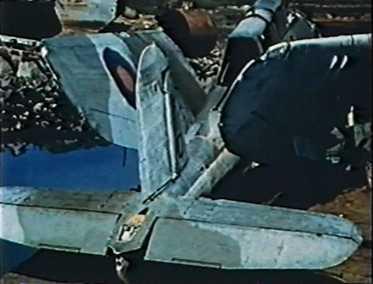
This rare colour image of a Skua is courtesy of Øyvind Lamo who runs the Operation Skua website. It shows Skua L2991 (8Q) from 803 Squadron. It was hit by gunfire in a dogfight with a Heinkel 111, over Åndalsnes in the Romsdalsfjord, on April 26th 1940. The aircraft made it to Ålesund, near the coast, and ditched in the harbour there. Still afloat, it was towed to a shipyard nearby and lifted ashore. The pilot, Lt.Cecil Howard "Kik" Filmer, survived and was rescued, but the Observer/Gunner Petty Officer K.G. Baldwin was hit during the dogfight and killed. Filmer was shot down again (in Skua L2963) during the raid on the Scharnhorst and was taken prisoner. He died on 15th July 2007 at the age of 92. His full story can be read at <this link>.
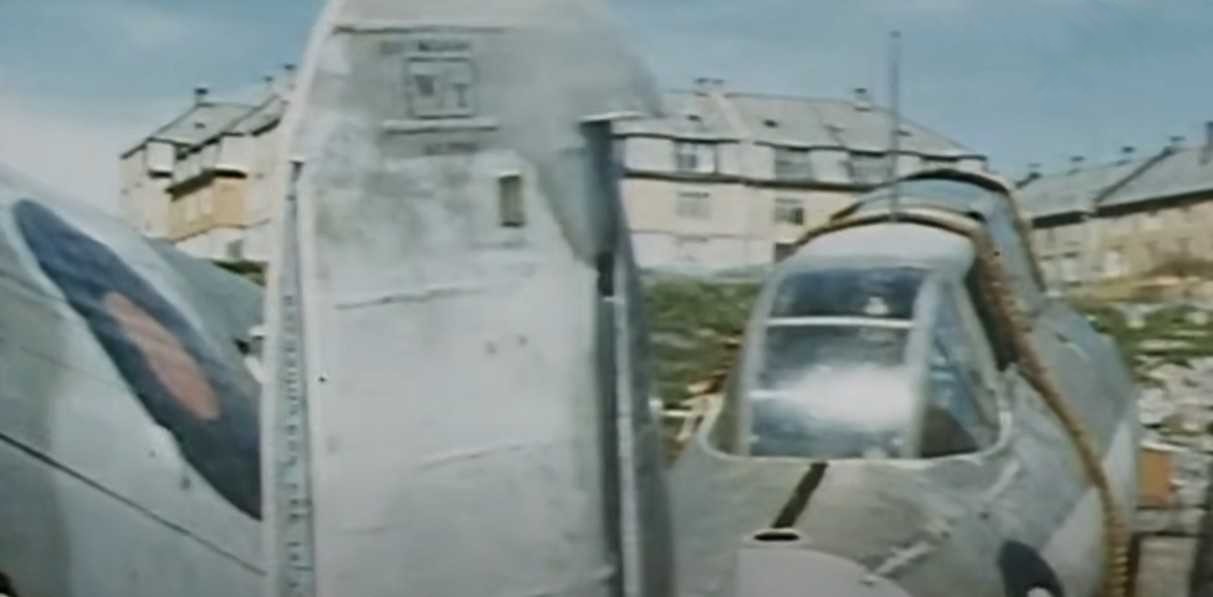
A colour image of the same Skua courtesy of Vidar Gjelsten. The Skua was largely dismantled before the Germans occupied the harbour. Its compass recovered to be used on a boat and a trolley, built for use around the harbour, utilised the undercarriage wheels.
A glimpse of the same Skua can be seen in this YouTube video (about 4 minutes in).

A colour image of the same Skua courtesy of Vidar Gjelsten. The Skua was largely dismantled before the Germans occupied the harbour. Its compass recovered to be used on a boat and a trolley, built for use around the harbour, utilised the undercarriage wheels.
A glimpse of the same Skua can be seen in this YouTube video (about 4 minutes in).
An 800 Squadron pilot, Petty Officer J Hadley was badly wounded that day. The Navy pilots were learning how to use their Skuas to the best advantage and on the following day they shot down 6 Heinkel 111s (some of these made it back to their bases but were written-off in crash-landings). At one stage over twenty bombers were driven off by the Skuas making dummy attacks, having used up all their ammunition. On this same day (the 27th) the British carriers were attacked by German bombers but were beaten off by Gladiators from Glorious. The Sea Gladiators from Glorious had been protecting the aircraft carriers themselves but the Glorious had had to leave to refuel on the evening of the 27th leaving the Ark Royal's Skuas and Blackburn Rocs to provide fighter cover for the 28th. The three Rocs of 803 Squadron being launched twice that day, when they drove off German aircraft shadowing the British carrier force. Three Skuas of 800 Squadron were sent to patrol over a convoy of British ships, they drove off attacks by several bombers. One of the Skuas, crewed by Captain Richard Thomas Partridge RM and Lieutenant Robin Souyhey Bostock RN shot down a Heinkel III. Shortly afterwards their Skua's engine failed and they had to land on a frozen lake. The crew of the Skua and the survivors of the Heinkel found refuge in the same cabin. Their story and the story of the recovery of the Skua from the bottom of the lake (it is now on display at the Fleet Air Arm Museum Yeovilton) can be found on the book "Operation Skua" by Richard Partridge. The story also formed the basis for the feature film "Cross of Honour". An archived copy of a website that was devoted to "Operation Skua" can be found at <this link>. On the 28th of April, six of Ark Royal's Skuas took part in an early-morning strike on Trondheim harbour, attacking merchant ships and float-planes, destroying five Heinkel 115s. One of the Skuas was unable to find its way back to Ark Royal and made a landing at the Setnesmoen landing ground. The crew managed to refuel their Skua and with the happy discovery of a discarded engine-starter cartridge were able to fly back to Hatston in the Orkney Islands on the 30th of April. Skuas were also in operation defending the fleet on the 28th April, Destroying no less than 3 Heinkel 111s and a Ju88 and damaging another six Heinkel 111s.
The Ark Royal withdrew into the Atlantic on the 29th and 30th and then joined up with the refuelled Glorious to approach the Norwegian coast on the 1st May (onboard the Glorious, along with her Swordfish and Sea Gladiators, were 3 Skuas and a single Roc of 803 Squadron). Spotted by the Luftwaffe, both carriers were subjected to a series of attacks by Junkers Ju 87 Stukas, during which Glorious, in particular, was very lucky not to be hit. With the threat of air attack now so high and with the possibility of U-boats making an appearance, there was no alternative but for the carriers to withdraw leaving Aandalsnes and Namsos to be evacuated without air-cover. However, the Skuas would be back in Norwegian skies within a week.
On the 4th of May, the Ark Royal set out from Scapa to give cover to the British and French forces attacking the northern Norwegian port of Narvik, important to the Germans for the shipment of iron ore from Sweden. While at Scapa all the Rocs had been flown off and all the Skuas transferred to Ark Royal, giving her a compliment of 23 Skuas shared between 800, 801 and 803 Squadrons. Arriving off the coast on the 6th May the Ark Royal's Skuas did not operate because of bad weather until the following day when sorties were flown over Narvik, one Skua being lost when its engine failed, happily the crew of Midshipman Treene with observer Naval Airman "Doc" Goble were able to be rescued (click here for the full story). Heinkel 111 formations were intercepted twice that day, again many of them jettisoned their bombs to make their getaways, but one was badly damaged, crashing back at its base. Return fire hit one Skua, forcing it to ditch but the crew were rescued by a British destroyer. On the 8th of May, three Skuas shot down one of the big four-engined Dornier 26 flying boats attempting to fly German reinforcements into Narvik, one of the Skuas was hit by return fire and had to ditch (crew rescued). On the 9th of May Skuas gave cover to Swordfish aircraft attacking the railway from Sweden to Narvik along which the Swedish iron ore was shipped, a viaduct and tunnel mouth were destroyed. One of the Skuas had to force-land but the crew walked to the coast and were saved. Flying patrols over the allied forces attacking Narvik the Skuas found that cloud provided cover for German bombers making their job more difficult, but in sixteen days of constant operations, they claimed six German aircraft and damaged another eight. Nine Skuas were lost, five due to enemy action but the only crew not saved were Lieutenant W.P. Lucy and his observer M.C.E. Hanson who were shot down on the 14th of May while engaging a force of 5 Heinkel 111s attacking the fleet. Narvik was outside the range of German single-engined fighters, but on the 16th May, the Luftwaffe sent twin-engined fighters, both Messerschmitt 110s and the fighter version of the Junkers 88, to escort their bombers. The Messerschmitts managed to shoot down one 803 Squadron Skua (but the crew were rescued) but were given a stiff fight in the process. Later in the day, a formation of six Ju88 fighters was engaged by 803 Squadron and two of them were destroyed for no loss to the Skuas.
On the 18th of of May, four Skuas of 800 Squadron caught two Blohm and Voss Bv138 flying boats unloading troops at Beisfjord and destroyed both by strafing.
While the carrier actions had been going on the Skuas of 806 Squadron began operating over southern Norway from Hatston on the Orkney Islands. This newly-formed squadron had mostly inexperienced pilots, nevertheless, they started spectacularly on 9th of May when they raided Bergen harbour, sinking the minesweeper M.134 ¹ alongside the Dokkeskjærskai quay and machine-gunning MTBs. On the 10th of May, they dive-bombed a complex of oil tanks near Bergen, succeeding in destroying all seven of the tanks, thus denying 19,000 litres of fuel to the Germans. On the 12th May, they returned to Bergen, but untrained in bombing moving targets, they failed to hit a large vessel entering the harbour. On the 15th of May another attack on Bergen had to be aborted because of fog. On the 16th of May, a further 6 oil tanks at three locations around Bergen were attacked and destroyed.
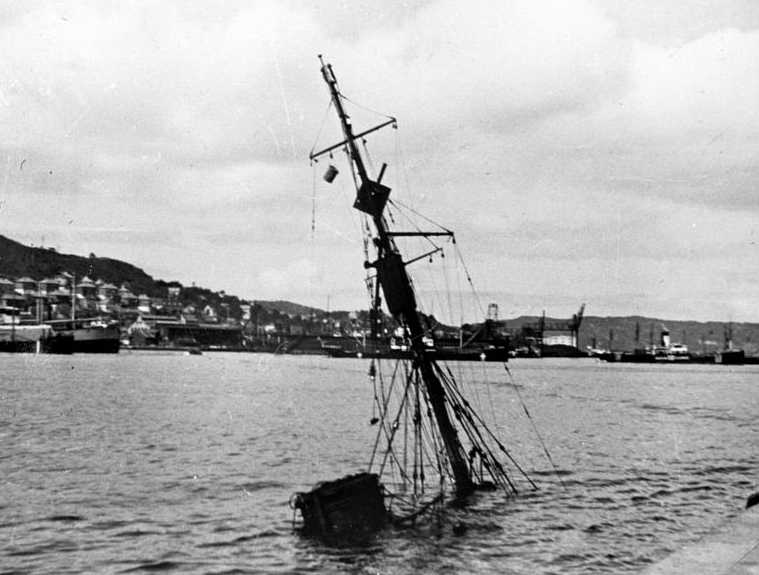
The mast of the Minesweeper M134, all that was left above water after it was sunk during a raid by 8 Skuas of 806 Squadron, escorted by 6 Blenheims of 254 Squadron. One of the Blenheims was hit by flak and crashed into the harbour with the loss of all three crewmen. Three German crewmen were killed when the M134 sank. Being sunk in harbour, the minesweeper was easily raised, being recommissioned in March the following year as the M534. This photo is courtesy of the Marcus Photo Database of the City of Bergen, the photographer being Leif M Endresen.
On the 21st May RAF Gladiators of 263 Sqdn were flown off HMS Furious to land at an airfield prepared at Bardufoss, north of Narvik. they were joined on the 26th by Hurricanes of 46 Squadron flown off HMS Glorious. This released Ark Royal to sail for Scapa on the 25th. French and British troops captured Narvik on the 29th.
In the meantime, the success of the German assault in the Low Countries and France had made the idea of holding onto the gains in Northern Norway impracticable and so the Ark Royal returned with Glorious to cover the evacuation of Allied forces. Bad weather helped the evacuation, keeping the Luftwaffe largely grounded. In the late afternoon of the 6th June, six Skuas of 803 Squadron carried out a bombing attack on a German HQ that intelligence had reported being in a hotel in the town of Fauske.
The Gladiators of 263 Squadron and the Hurricanes of 46 Squadron were flown onto HMS Glorious on the night of 7th/8th June but all were lost on the following day when the Glorious and her two escorting destroyers were destroyed by the big guns of the Scharnhorst and Gneisenau in circumstances that are still controversial. In the fight, the Scharnhorst was damaged by a torpedo and had to put into Trondheim for repairs, arriving on the 9th June. An RAF recce flight spotted it in harbour the same day.
Meanwhile, HMS Ark Royal escorted convoys from Narvik, its Skuas shooting down a Heinkel 111 and damaging another, along with damaging a Heinkel 115, on the night of 9th June (the northerly latitudes meant it never got dark). The following day a Heinkel 115 was shot down by three Skuas of 803 Squadron.
The presence of the damaged battlecruiser Scharnhorst in Trondheim harbour, along with other German warships, was a tempting target. It must have seemed that a repeat of the sinking of the Königsberg by Skuas was possible. However there were important differences, the Königsberg had been a light cruiser whose armour could be easily penetrated by the 500 lb bomb carried by Skuas, whereas the much more heavily armoured battlecruiser Scharnhorst was much better protected and unlikely to be badly damaged by such weapons (later in the war, the Scharnhorst was badly damaged by two 500 Ib bombs dropped from Halifax bombers, so perhaps there was a chance of some success). The Königsberg had been attacked in the first days of the Norwegian campaign before the Germans could put fighter and flak defences in place, whereas they had ample opportunity to put defences in place at Trondheim. Bergen, where the Königsberg was sunk, is fairly near the open sea allowing little time for observers on the coast to spot incoming aircraft while Trondheim is some distance inland, being reached by a long fjord, giving ample warning of the approach of aircraft. Trondheim was too far North to be reached by Skuas flying from land bases so such a strike would have to be flown off the Ark Royal.
A plan was devised to attack the Scharnhorst. Fifteen Skuas would be launched from Ark Royal in the middle of the night (although it would still be light, Trondheim being close to the Arctic Circle). An attack by RAF Beauforts on the main German aerodrome at Vaernes was planned to disrupt any German fighter response and support was to be given by long-range Bleinheim fighters.
In the meantime, the RAF tried to hit the Scharnhorst on the 11th of June, when a force of twelve Hudson bombers of 269 Squadron, flying from Wick in Scotland, attacked at medium altitude, but not a single hit was scored. Two of the Hudsons were shot down by German fighters. It is hard to see what this attack hoped to achieve since the bombs the Hudsons carried were 250 pounders, half the size of those carried by Skuas. This attack must have served to only heighten the alert of the Germans.
The Skua raid was launched on the night of the 12th/13th of June. Six Skuas from 800 Squadron and nine from 803 Squadron flew off the carrier at around midnight. They crossed the coast at 01.23 hrs, still 20 minutes from their target. The RAF attack on Vaernes had the opposite effect to that intended, swarms of Luftwaffe aircraft took off in response to it and were in exactly the right position to attack the incoming Skuas. The Skuas split into two formations, 800 Squadron attacked the Scharnhorst stern to bow while 803 Squadron ran in from the other direction, bow to stern. Two hits were claimed, but German records admit to only one, and that did not explode. The Skua crews fought for their lives through the flak from the Scharnhorst and the other German naval vessels in the harbour, and from the Messerschmitt Bf109 and 110 fighters that swarmed around them. Eight of the fifteen Skuas were shot down, including the commanders of both 800 and 803 Squadrons (Lt Cdr Casson and Capt R.T. Partridge). The survivors only got away by flying low in the early morning mist, claiming a single Messerschmitt 110 damaged. The RAF Blenheims turned up only after the attack was over.² One of the surviving Skua pilots was 24-year-old Donald Gibson, much later to become Vice-Admiral Sir Donald Gibson. In his memoirs, Gibson compared the attack on the Scharnhorst to the Charge of the Light Brigade and said: "In future all admirals should ideally be shot at in an aeroplane while they are still young." ³
A much more detailed account of the attempt to sink the Scharnhorst can be read on historian Matthew Willis' website at <this link>.
803 Squadron went ashore at the Orkney Islands to operate from Hatston, along with 801 Squadron, flying missions to the Norwegian coast around Bergen and keeping up the pressure on the Germans during the crucial summer and autumn of 1940 (meanwhile 800 Squadron had stayed with the Ark Royal as it sailed for the Mediterranean). Shipping and the numerous oil tank installations around Bergen, were the most common target for the Skuas and they proved much more effective than conventional "level" bombers but they met increasing numbers of Messerschmitt Bf109 fighters and these took an escalating toll. On the 13th of September, two Skuas were lost to Bf109s of JG5 . During November 1940, the famous test pilot Captain Eric "Winkle" Brown participated in one of these raids. Also during this period, the aircraft carrier HMS Furious was used for brief missions to enable the Skuas to strike at targets further north along the Norwegian coast. Following one such attack by 801 Squadron launched from Furious against Trondheim on 22nd September Skua L2942 piloted by Sub Lt Bernard Wigginton with Leading Aircraftsman Kenneth King as his gunner, was unable to find the Furious and had to crash land in neutral Sweden; the first allied aircraft to do so.⁴ HMS Furious was used to launch another such attack by 801 Squadron this time against Tromso on 16th October, when another Skua was forced to land in Sweden.
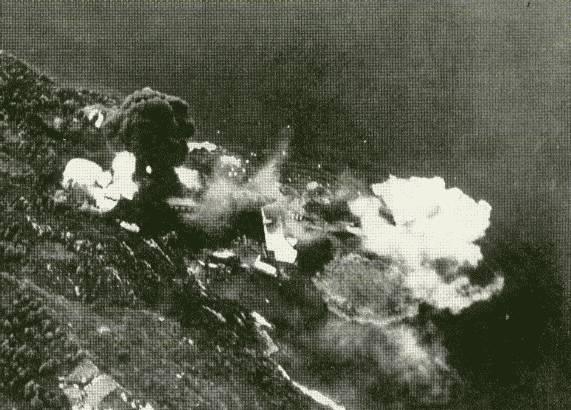
On the left of the picture, a huge black mushroom cloud rises while ripples from other bomb blasts fan out in the water after a raid by Skuas on a fuel installation at Dolvik not far from the modern Bergen airport.
HMS Furious left for a brief mission to the coast of West Africa in early November taking 801 Squadron with it (click here for more details). They returned at the end of December and flew missions against Norway again on the 27th December and 5th January 1941. This was the Skua's last operational mission over Norway. The Skuas were then concentrated at St Evel in Cornwall, from where it was hoped to strike at the German battle-cruisers Scharnhorst and Gneisenau in Brest Harbour, a mission that promised to be a tragic re-run of the raid against the Scharnhorst in Norway (although it was hoped to launch the attack at night). The Skuas did take part in raids on Alderney in the German-occupied channel islands and Cherbourg while waiting for the "big show". In the event, a series of German bombing raids against St Eval destroyed enough Skuas to force the abandonment of the Brest raid.
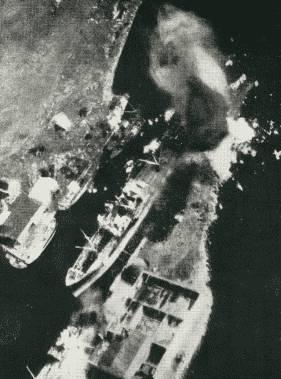
A Skua strike against a German supply ship in the harbour at Hagesund.
Skua Victories in the Norwegian campaign
The meticulously researched book "Flying sailors at War" by Brian Cull with Bruce Lander and Mark Horan lists some 40 enemy aircraft verified destroyed by Skuas during the Norwegian Campaign (see Appendix II in the book). These are not just claims, they correspond with German records. To list them by type.
Blohm and Voss BV138 Flying Boat - 2 destroyed by strafing
Dornier Do 26 Flying boat - 1 destroyed
Dornier 18 flying boat - 3 destroyed.
Heinkel 115 floatplane - 12 destroyed, 10 of these by strafing
Henkel 111 bomber - 9 destroyed in the air, another 8 damaged and written off after crash-landing.
Junkers Ju 88 - 5 destroyed
Notes
¹ From photo reconnaissance beforehand, the British had expected to find the gunnery training ship Bremse alongside the Dokkeskjærskai quay. Because of its large guns, the Bremse was classed by the British as a light cruiser, even though it was only as big as a destroyer. The combat reports, sometimes quoted in accounts of the attack, reflect that the pilots thought they had hit a light cruiser. In fact, they had sunk the M.134, an ocean-going minesweeper that had been commissioned in 1920. During the 1920s it had been renamed the Fraunlob and used as a depot ship but was then converted back to a minesweeper and given its old name back when Hitler came to power. Being sunk in harbour, the M.134 was easily refloated and repaired, being recommissioned in March 1941 as the M.534 and subsequently given the name Jungingen. Used as a patrol vessel, rather than a minesweeper, it was heavily damaged in an action in the English Channel in September 1943, after which it was used as a depot ship again.
² Richard Bartlett, pilot of one of the Skuas shot down in the raid on the Scharnhorst, met Joe Hill, pilot of one of the Blenheim long-range fighters while they were both POWs in Germany and they became close friends. In the biography of Bartlett, "One Man's War" by Stuart E Soward, there is speculation that the late arrival of the five Blenheims was due to a mix-up by the navigator planning the Blenheim mission between nautical miles and miles. Other sources say it was because of a strong headwind. Incidentally, Joe Smith was the pilot of the recce flight that first discovered the Scharnhorst to be at Trondheim.
³ The August 2007 issue of Aeroplane magazine features an outstanding article "Into the Fjord of Death" by Matthew Willis and Simon Partridge. It covers the attack on the Scharnhorst at Trondheim in detail.
⁴ An article by Lennart Berns on Skua L2942's arrival in Sweden appeared in the June 2006 edition of Flypast magazine. Interestingly the photos show that at this stage Skuas were flying with bullet-proof glass fitted to the front windscreen. Peter C. Smiths book "Skua- The Royal Navy's Dive Bomber" features an interview with Ken King that reveals the reasons why they could not locate HMS Furious or make it back to Sumburgh.
² Richard Bartlett, pilot of one of the Skuas shot down in the raid on the Scharnhorst, met Joe Hill, pilot of one of the Blenheim long-range fighters while they were both POWs in Germany and they became close friends. In the biography of Bartlett, "One Man's War" by Stuart E Soward, there is speculation that the late arrival of the five Blenheims was due to a mix-up by the navigator planning the Blenheim mission between nautical miles and miles. Other sources say it was because of a strong headwind. Incidentally, Joe Smith was the pilot of the recce flight that first discovered the Scharnhorst to be at Trondheim.
³ The August 2007 issue of Aeroplane magazine features an outstanding article "Into the Fjord of Death" by Matthew Willis and Simon Partridge. It covers the attack on the Scharnhorst at Trondheim in detail.
⁴ An article by Lennart Berns on Skua L2942's arrival in Sweden appeared in the June 2006 edition of Flypast magazine. Interestingly the photos show that at this stage Skuas were flying with bullet-proof glass fitted to the front windscreen. Peter C. Smiths book "Skua- The Royal Navy's Dive Bomber" features an interview with Ken King that reveals the reasons why they could not locate HMS Furious or make it back to Sumburgh.
Sources
LINKS
Story of Lloyd Richards, survivor of the Scharnhorst raid, on BBC Guernsey Website.
Paper on the British Navy air operations over Noway by Peter Hore
Archived copy of the excellent "Operation Skua" website on the "Wayback Machine".
Story of Lloyd Richards, survivor of the Scharnhorst raid, on BBC Guernsey Website.
Paper on the British Navy air operations over Noway by Peter Hore
Archived copy of the excellent "Operation Skua" website on the "Wayback Machine".
